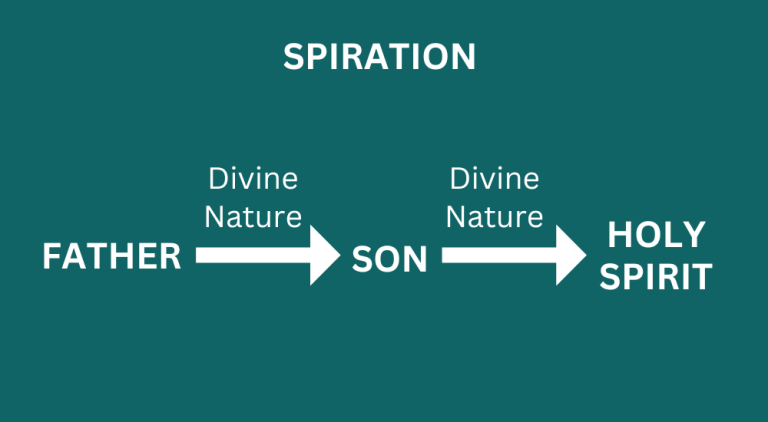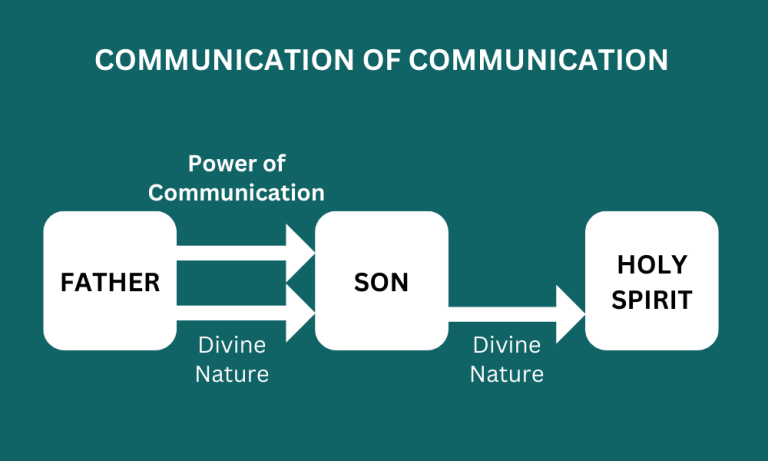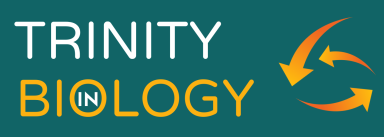What is
THE HOLY TRINITY?
NOT INCOMPREHENSIBLE
If the Holy Trinity were an impenetrable mystery which nobody understood, it would be impossible to see the image of the Holy Trinity in a physical object like the cell. And anyone who claimed such a thing would be deluding themselves.
However, this is not the case. Why? Precisely because the Holy Trinity is not the incomprehensible mystery it is almost universally believed to be. The notorious reputation attached to the Trinity is a gross misconception. Christian theology has a very clear picture of the Trinity, which is logical and beautiful. However, the Trinity is not intuitive, indeed, no human being could ever have known that God is a Trinity. But now that it has been revealed to us, it makes perfect sense. We associate intricate structure with matter, not spirit, let alone God. But the Holy Trinity is a structure. So, there is far more to the Holy Trinity than an old man with a long white beard and a hovering dove! But how do we know that the Christian doctrine on the Holy Trinity is correct? Because we have scientific proof: the image of the Holy Trinity in the cell. But to see this proof, we first need to understand the Holy Trinity.

| The Holy Trinity is a comprehensible structure.
Why
THREE?
Trying to understand why the Holy Trinity is three by staring at the number three, is like trying to understand chemistry by staring at the Periodic Table of Elements.
The triplicity of God is a direct consequence of what God is. And this is not an unfathomable mystery. In fact, it is something the modern world is immersed in today living in the Information Age: communication. As the Gospel of John famously begins: "In the beginning was the Word..."
So, God is communication, what's more, communication in eternity is essentially no different from communication here on Earth - it consists of two basic activities: giving and receiving. Now, there is an interesting consequence of communication - there are exactly three different ways to communicate: (1) Give, (2) Give and Receive, and (3) Receive. There are no other ways to communicate.

There are precisely three ways to communicate.
FATHER, SON & HOLY SPIRIT
Identical Yet Different
Now, imagine a realm where there is only communication (this is not too much of a stretch given how connected the world is nowadays). In this realm of communication, the only differences which can exist are the three different types of communication. This realm exists. It is what we call God. These three differences are the three Persons of the Holy Trinity.
On the one hand, the Father, Son and Holy Spirit are absolutely identical in terms of their divinity. Yet on the other hand, they are truly different because of communication: the Father only gives the divine nature, the Son gives and receives, while the Holy Spirit only receives.
Since God exists outside of space, time, matter and all other substances or objects, there are no other ways God can be internally distinguished, other than these three ways of communication. God not only can be three, God must be three, no more, no less. God is Trinity.

| The three Persons of the Holy Trinity.
The Father is the
ORIGIN OF THE SON
The Father gives the divine nature to the Son. The Father is therefore the origin of the Son. That's why he is called the Father.
There is only one thing to communicate in God and that is God itself, or the divine nature. This can only be communicated in its entirety because it is absolutely indivisible. So, communication in the Trinity is not merely a divine conversation, it is production. Communication of the divine nature results in a another divine person.
"All that the Father is or has, he has
not from another but from himself,
he is the origin without origin.
All that the Son is or has,
he has from the Father,
he is origin from origin".
________________
THE GENERAL COUNCIL OF FLORENCE
Decree for the Copts (1442)
GENERATION
The Son is God, like the Father. But unlike the Father who has no origin, the Son is generated by the Father, who communicates the divine nature to the Son.
The Father is God without origin, whereas the Son is God with origin. Since there is no beginning or end to the divine nature. There is no beginning or end to the Son's origin, The Father spends all eternity generating the Son.

| The Father is the origin of the Son.
THE FATHER AND THE SON
Are the Origin of the Holy Spirit
The Father is the source of all divinity in the Trinity. This means the Father is the origin of the Holy Spirit. However, the Holy Spirit cannot be another Son, because each divine person must be different, just as all human persons are different.
The Holy Spirit is different from the Son because, unlike the Son, the Father does not communicate the divine nature directly to the Holy Spirit. Rather, the Father communicates to the Holy Spirit through the Son. That is, both the Father and the Son are the origin of the Holy Spirit.
"All that the Holy Spirit is or has, he has
at once (simul) from the Father and the Son.
But the Father and the Son are not two
origins of the Holy Spirit but one origin,
just as the Father, Son and Holy Spirit
are not three origins of creation
but one origin"
________________
THE GENERAL COUNCIL OF FLORENCE
Decree for the Copts (1442)
Spiration
Christian theology uses the term SPIRATION to describe the origin of the Holy Spirit - just as a pair of lungs act in unison, so the Father and the Son act together to breathe or spirate the Holy Spirit.

| Both the Father and the Son are the origin of the Holy Spirit.
The Trinity is as easy as
ONE, TWO, THREE
(Well, almost)
ONE
God

The Holy Trinity is one God because there is only one divine nature which is communicated throughout the Trinity.
TWO
Processions

Generation and spiration are called the two processions in Christian theology because the Son and the Holy Spirit originate or proceed from them.
THREE
Persons

The Holy Trinity is therefore one God who, through the two processions, is three Persons: Father, Son and Holy Spirit.

| The Holy Trinity is (almost) as easy as one, two, three.
.
.
.
.
Why
NO FOURTH PERSON?
The Father is the origin of the Son, and the Father and the Son are the origin of the Holy Spirit. However, the Father, Son and Holy Spirit are not the origin of a fourth divine person. This is because the Holy Spirit does not communicate the divine nature.
The production of a divine person requires the communication of the divine nature. However, the communication of the divine nature abruptly ceases at the Holy Spirit, since the third Person of the Trinity does not have the power to communicate the divine nature (the Holy Spirit receives but does not give the divine nature). And since there is no fourth divine person, there is no fifth or sixth or seventh or, indeed, an infinite number of divine persons. The third person is the end-point of all communication - once the divine nature reaches the Holy Spirit, it doesn't get out again. So, the Church has not got its maths wrong, God is not a Holy Quaternity.

| There are no other divine persons beyond the Holy Spirit - hidden or otherwise - because the Holy Spirit doesn't communicate the divine nature.
The Trinity
in TIME
How do we know the doctrine of the Holy Trinity is correct, after all, the Trinity exists outside the universe? The reason is because the Holy Trinity has appeared in time. That is, the three Persons of the Trinity have appeared - in one way or another - in human history.
The Father, Son and Holy Spirit have not appeared in a random way, but in a way which reflects their existence in eternity. You could say the Holy Trinity is the image of itself in time. There are two main ways in which the eternal structure of the Trinity is revealed in time: the order in which the three Persons appear, and the silence of the Holy Spirit.
according to Christianity,
ORDER OF APPEARANCE
Have you ever wondered why God the Son became man, and not the Father or the Holy Spirit? Why didn't the Father sacrifice Himself on the cross instead of sacrificing his Son?
The ...
THE HOLY SPIRIT IS SILENT
Not only does the Father have the spiritual apparatus for communication (since the Father has everything), but the Father is able to communicate this apparatus to the Son, along with the divine nature. Hence why the Son can communicate the divine nature to the Holy Spirit.
But whereas the Son can communicate the divine nature, the Son cannot communicate the power of communication - the spiritual apparatus necessary for communication - to the Holy Spirit. The result is another divine person who is fully divine, but who cannot communicate the divine nature: the Holy Spirit.
THE SILENCE
of the Holy Spirit
Lorem ipsum dolor sit amet, consectetur adipiscing elit. Nulla euismod condimentum felis vitae efficitur. Sed vel dictum quam, at blandit leo.
COMMUNICATION OF COMMUNICATION
Communication is of course absolutely central to the Holy Trinity - the Father communicates, as does the Son. So, how come the Holy Spirit doesn't? While this seems peculiar, if not paradoxical, at first sight, there is an explanation.
The divine nature is not the only thing communicated in the Trinity. Something else is communicated: the power or ability to communicate the divine nature. Being a divine person by itself, is actually not enough to be able to communicate the divine nature. A divine person also needs the spiritual apparatus to enable the communication of the divine nature.
Not only does the Father have the spiritual apparatus for communication (since the Father has everything), but the Father is able to communicate this apparatus to the Son, along with the divine nature. Hence why the Son can communicate the divine nature to the Holy Spirit.
But whereas the Son can communicate the divine nature, the Son cannot communicate the power of communication - the spiritual apparatus necessary for communication - to the Holy Spirit. The result is another divine person who is fully divine, but who cannot communicate the divine nature: the Holy Spirit.
| The Father communicates the power of communication to the Son. However, the Son does not do the same to the Holy Spirit. Which is why the Holy Spirit, though divine, does not
communicate the divine nature.

The Holy Trinity has a
BEGINNING, MIDDLE and an END
The Trinity has no beginning or end
The Holy Trinity is eternal, that is, the Father, Son and Holy Spirit have neither beginning or end. However, the Trinity does not have a cyclical pattern of communication without beginning or end.
T
The divine nature in the Trinity flows in one direction, that is, from the Father to the Son and finally into the Holy Spirit. Therefore, the structure of the Trinity does have a beginning and an end, and even a middle.
The structure
The Trinity has direction since the divine nature is strictly communicated in one direction, from the Father, to the Son and finally into the Holy Spirit. In terms of existence the Father, Son and Holy Spirit are without beginning or end, they are co-eternal. However, in terms of communication, the Trinity has an order: the Father is the beginning, the Son is in the middle and the Holy Spirit is the end.
By definition, God is eternal. This means God has neither beginning or an end. It would therefore be tempting to assume that God communicates in a cyclical pattern as this is without beginning or end. However, this is not the case at all in the Trinity. Communication in the Trinity not cyclical, but LINEAR.
Beginning
(Father)
The Father does not receive the divine nature from anyone or anywhere else, he is the beginning of communication.
Middle
(Son)
The Son receives His divine nature from the Father, and the Son also communicates it to the Holy Spirit. The Son is therefore in-between the Father and the Holy Spirit.
End
(Holy Spirit)
The Holy Spirit is the endpoint of all communication in the Trinity. Just as the Father is an infinite source, so the Holy Spirit is an infinite sink of divinity.
NOT THE TRINITY

| The Trinity does not have a cyclical pattern of communication because there is no difference between the divine persons in such a pattern: they each give and receive.
THE HOLY TRINITY

| Counter-intuitively, the Holy Trinity is uni-directional communication: the structure of communication has a beginning and an end, as well as a middle.
The Trinity is
LOOPY
4. UNI-DIRECTIONALITY
IMAGE
Communication in One Direction
If we now consider the Father, Son and Holy Spirit together, as a unified whole (after all, they are one God because they are united by the communication of the same divine nature), we find the divine nature is communicated in quite an unexpected pattern. It is not communicated in an endless cycle without beginning or end as we might expect for God who has no beginning or end. Rather, the Holy Trinity is LINEAR. Eternity has a direction! There is an arrow of communication, running from the Father, to the Son and finally into the Holy Spirit.
Beginning
(Father)
The Father does not receive the divine nature from anywhere else. This is because the Father is the source of all divinity in the Trinity. That is, the Father is the origin of the Son and the Holy Spirit's divine nature.
Middle
(Son)
The Son receives His divine nature from the Father, and the Son also communicates it to the Holy Spirit. The Son is therefore in-between the Father and the Holy Spirit.
End
(Holy Spirit)
The Father communicates the divine nature to the Holy Spirit through the Son. The Holy Spirit is the endpoint of all communication in the Trinity. Just as the Father is an infinite source, so the Holy Spirit is an infinite sink of divinity.
5. ORIGINS
IMAGE
5.1 Who Made God?
If God exists, then who made God? This is becoming an increasingly popular question to ask nowadays. There are two answers to this question - not alternative answers, there are actually two answers. First, God has no origin. Second, the origin of God is God. There is no contradiction here at all. In fact, there's more. Not only does God have no origin, and God is the origin of God's own self, but God has multiple origins.
5.2 Internal Origins
God has no origin because nothing existed before God. God is the only entity who is without origin - everything else which exists has an origin. If your god had an origin then, sorry, it's not really god. This is why the question, "who made God?", seems silly at first, because the very definition of God is to have no origin. But it turns out, it is not silly at all. Because if we look inside God, what we find are internal origins.
5.3 The Trinity Must Have Internal Origins
The Father, Son and Holy Spirit are each fully divine, however, if they were each without origin, they would be three separate gods. This is not the case. They are one God, because they are inseparably united to one another by communication of one and the same divine nature. The difference between the Father and the Son is that the Father does not receive His divinity from anyone and anything else, whereas the Son receives His divinity from the Father. In other words, the Father is the origin of the Son.
5.4 None of the Persons Existed Beforehand
The Father did not exist before the Son, because the Son did not have a beginning. Having an origin is not the same as having a beginning. The Son has an origin (the Father) but not a beginning. The Son has no beginning because He is divine nature has no beginning or end. Having said that, the Father does not communicate the divine nature to the Son once, it takes all eternity for the Father to communicate the infinite divine nature to the Son. In sum, while the Son has always co-existed with the Father, the Father eternally generates the Son.
5.5 How? Answer: Communication
As tempting as it may be to conclude the Holy Trinity is an eternal computer network, communicating infinite information, this is not the case (though there are real parallels of course). It is stating the obvious, that before any communication can take place on the network, the network must first be constructed. It is also obvious to state that the construction cannot be performed by the network itself - because it doesn't exist! Instead, like any physical entity, a computer network is constructed by something other than the network, in this case, human beings. This is not the case with the Trinity. The Holy Trinity is not made by anything else. Rather, the Holy Trinity re-generates itself by communicating its own divine nature, to the Son and the Holy Spirit. In a computer network, communication is merely the transfer of information from one place to another. In the Trinity, communication is not merely a transfer, it is production.
5.6 Uni-Directionality Makes Even More Sense
Exactly the same logic applies to the Holy Spirit. Just because the Father and the Son are the origin of the Holy Spirit does not mean the Holy Spirit came into existence after the Father and the Son. The Holy Spirit has existed from all eternity, but the Father and the Son are the eternal source of the Holy Spirit. Uni-directional communication makes perfect sense now precisely because it is the cause of the Son and the Holy Spirit. Communication in the reverse direction would result in utter chaos.
6. GENERATION & SPIRATION IMAGE
The Two Origins Within the Trinity
At the heart of the Trinity are therefore two communication processes which are the origin of the Son and the Holy Spirit respectively. Christian theology gives these processes the general name of processions, precisely because the Son and the Holy Spirit proceed (originate) from them. Theology goes further than this. The procession of the Son and the Holy Spirit have different names - because they are different. They have to be different, because wherever there is plurality in the Trinity, there must be a real difference. Simply put, not only is the Son different from the Holy Spirit, but their origins are also different.
The last public pronouncement made by the Catholic Church on the doctrine of the Holy Trinity was at the General Council of Florence in 1442. The Church did not say anything new about the Trinity, it merely restated what it had known for centuries, in a clear and concise manner. To put this in some historical context, in 1543, that is, 101 years later, Nicholas Copernicus published, On the Revolutions of the Heavenly Spheres (De Revolutionibus Orbium Coelestium), which proposed the heliocentric model of the solar system and sparked the advent of modern science.
All that the Father is or has, he has not from another but from himself; he is origin without origin. All that the Son is or has, he has from the Father; he is origin from origin. All that the Holy Spirit is or has, he has at once (simul) from the Father and the Son. But the Father and the Son are not two origins of the Holy Spirit but one origin, just as the Father, Son and Holy Spirit are not three origins of creation but one origin.
GENERATION: Origin of the Son
If God exists, then who made God? This is becoming an increasingly popular question to ask nowadays. There are two answers to this question - not alternative answers, there are actually two answers. First, God has no origin. Second, the origin of God is God. There is no contradiction here at all. In fact, there's more. Not only does God have no origin, and God is the origin of God's own self, but God has multiple origins.
SPIRATION: Origin of the Holy Spirit
God has no origin because nothing existed before God. God is the only entity who is without origin - everything else which exists has an origin. If your god had an origin then, sorry, it's not really god. This is why the question, "who made God?", seems silly at first, because the very definition of God is to have no origin. But it turns out, it is not silly at all. Because if we look inside God, what we find are internal origins.
© 2025 TRINITY in BIOLOGY
We need your consent to load the translations
We use a third-party service to translate the website content that may collect data about your activity. Please review the details in the privacy policy and accept the service to view the translations.
